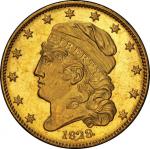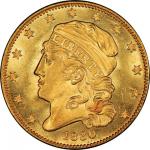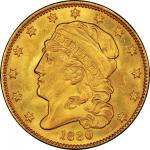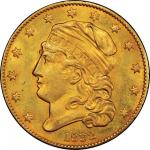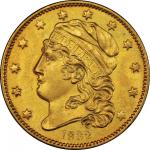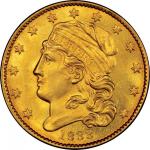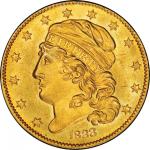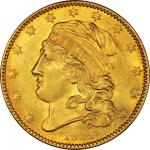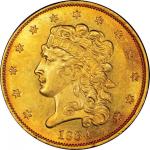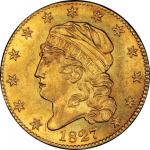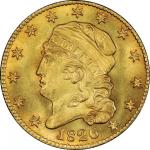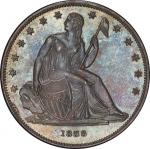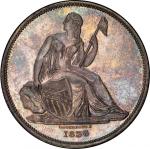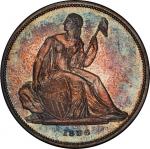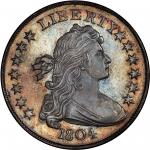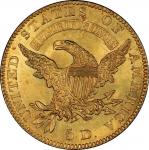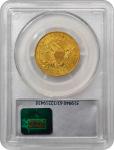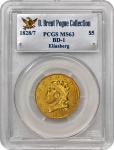But to go back to the Parmelee collection. Its most important department, intrinsically, was that of gold coins, it containing a specimen of every gold coin minted in the country from 1795, when the coinage of this class of money was begun, down to date. A large part of this portion of collection was purchased by Mr. Parmelee from Mr. George Seavey of Cambridge a few years ago for $15,000.”— Ebenezer Locke Mason, Jr., to the Boston Daily Herald, as quoted in Mason’s Coin Collector’s Magazine, June 1890</em>Another legendary rarity in the series, the D. Brent Pogue specimen of the 1828/7 has been sold publicly just twice since the dawn of the 20th century, most recently 34 years ago. The surfaces are deep yellow, fairly even on the obverse with some subtle copper spotting in nonfocal areas, brighter and more lustrous on the reverse, where some more natural appearing coppery toning is found around the periphery. Both sides are lightly reflective, but the reverse also shows a wealth of swirling satiny luster. Very well struck for this issue, without the weakness seen on the reverse of the Bass coin, this piece shows exceptional detail among all hair curls, Liberty’s cap, and every feather of the eagle. Its crispness sets it apart from other survivors of this rarity, though it shows the same lack of definition on the leftmost shield pale seen on others from these dies. The obverse shows light if thorough hairlines, along with copper spots below E of LIBERTY and left of her earlobe, both hidden among her curls. The reverse shows inconsequential hairlines and a light abrasion above 5 of the date. The overdate is bold, with the underdigit clearly seen under even low magnification. Some very subtle horizontal lapping lines cross the date digits. The reverse is in essentially the same die state seen on the 1827 above; all known specimens of 1827 use the same reverse die as this 1828/7 variety, though the unique Bass 1828/7 BD-2 uses the same reverse seen on non-overdate 1828 half eagles. The area of “shallow rust” among the olive stems is visible here, slightly diminished at its right end by lapping. The obverse and reverse dies are aligned in perfect coin turn.As august as this coin’s provenance to Parmelee, H.P. Smith, Clapp, and Eliasberg may be, its history of ownership appears to extend back even further, to the cabinet of Cambridge, Massachusetts numismatist George A. Seavey. Seavey’s collection was renowned, particularly for its complete complement of the United States gold coins, which Seavey had assembled before 1864. <em>The Historical Collections of the Essex Institute</em>, published by the well known historical repository in Salem, Massachusetts, commented in February 1864 “Mr. Seavey also showed the two half-eagles by the acquisition of which he had completed his series of the issues of gold of the United States. Other gentlemen exhibited coins of less value and interest.” Seavey was fond of displaying his gold coins, and a complete inventory of them was even published in the <em>American Journal of Numismatics </em>in March 1869. “Mr. G.F. Seavey exhibited an exceedingly rare and valuable collection of gold coins, comprising all the regular issue of the United States from the first eagle and half-eagle in 1795, down to the present time,” the Journal reported. “Among them were the unique half-eagle of 1815, and the scarce half-eagles of 1822 and 1828.” In 1873, Brooklyn numismatist William Strobridge prepared the Seavey collection for sale. Amidst his cataloging effort, Lorin Parmelee got wind of the upcoming offering, and arranged to purchase it outright, the first of several intact cabinets he would acquire on his way to building the most impressive cabinet of American coins assembled in the 19th century. Strobridge, wanting to waste neither the cataloging effort he had already put in nor the chance to hitch his name to one of the most famous cabinets of the era, published<em> A Descriptive Catalogue of the Seavey Collection of American Coins, the Property of Lorin G. Parmelee of Boston</em>, a listing of the coins included in Seavey’s cabinet, along with several photographic plates. Reviewers panned the effort. The editor of the <em>American Journal of Numismatics</em> “obtained a copy of this volume at the owner’s price of three dollars, and have seldom felt as if we had received less for our money,” stringing together several paragraphs of petty complaints in the January 1874 issue. The<em> Descriptive Catalogue</em> enables modern students to sort out which of Parmelee’s rarities came from Seavey. After Parmelee’s acquisition of the Seavey collection, William Strobridge cataloged a sale made up of the lower grade duplicates that were now redundant in the joint Seavey-Parmelee cabinet. A single 1828 half eagle was included in that sale as lot 788, described as “next in rarity to 1815” and graded Extremely Fine. Lot 483 of Strobridge’s <em>Descriptive Catalogue</em> was an 1828 half eagle described as “Proof.” It’s clear that the Seavey coin represented an exceptional upgrade and thus became Parmelee’s keeper, remaining in his cabinet until it was sold in 1890.When it was time for Parmelee to sell, he chose the partnership of Harlan Page Smith and David Proskey, doing business as New York Coin and Stamp Company. John W. Adams termed Harlan Page Smith “a man with genuine numismatic talent,” noting that “a close reading of his catalogs reveals a man with a rare sense of humor,” while in Adams’ estimation Proskey, “did the bulk of the cataloguing” for the partnership, was “perhaps the greatest numismatist this country has produced.” “Bro. H.P. Smith out-generalled the whole crowd,” crowed Ebenezer Locke Mason, Jr. in the pages of his <em>Mason’s Coin Collectors’ Magazine</em> in June 1890. W. Elliot Woodward’s career was all but over in 1890, and the Chapman brothers, despite a string of notable successes, had not yet come into their own. Smith and Proskey were in the right place at the right time to land one of the most significant numismatic consignments ever sold in this country.Smith, the money behind the partnership, was also a passionate collector who, the Chapman brothers noted in 1906, was “during the later period of his life engaged actively in dealing [but] always endeavored to improve his own private cabinet.” Bidding for his own cabinet under the name “Jack,” Smith was an active buyer at the Parmelee sale. He bought Parmelee’s 1792 Silver Center cent, his gem Mint State 1787 Maris 53-j New Jersey copper, and the famous 1815 half eagle. Smith’s named copy of the Parmelee catalog survives today, revealing his purchases, and perhaps a bit of his sense of humor: when he bought back the 1822 half eagle he had inserted into the Parmelee sale to take the place of Parmelee’s specimen that has been determined to be a counterfeit, he used “Black” rather than “Jack” as his bidder name.Though Smith died in 1902, his collection was not sold until 1906, placed in the care of the Chapman brothers. It was the last catalog they would issue as a partnership before going on to their own separate and successful careers. At this Smith sale, where this coin was undergraded as “Extremely Fine. Superb specimen,” it was purchased by John H. Clapp. When the Clapp collection was appraised for Louis Eliasberg in 1942, Maryland dealer John Zug called this coin “Proof,” and Walter Breen followed suit in his half eagle monograph in 1966. Since 1982, when the cream of Clapp’s collection of gold coins was brought to market as part of the Eliasberg cabinet, this coin has been in the Pogue Collection, this offering marking just its second auction appearance since the Parmelee sale of 1890.There are two varieties of 1828/7 half eagle, struck from the same obverse die but different reverses. This variety, BD-1, is among the rarest of all half eagles of this type, but is only the second rarest 1828/7. Four examples are known, while 1828 BD-2 is unique, first identified by Andrew W. Pollock III before 1996. This is at least tied as the finest known 1828 BD-1, surpassing the Newcomer-Green-Farouk-Clifford Smith-1976 ANA-Naftzger-Bass coin that remains impounded in the Harry Bass Foundation. It is comparable, perhaps finer, than the Byron Reed-Dr. Juan XII Soros specimen that was last sold as MS-64 (NGC) in January 2012. The only other confirmed example of this die marriage is the Lilly coin, part of the National Numismatic Collection at the Smithsonian Institution. The unique BD-2, certified as AU-55, is the only other 1828/7 half eagle seen by PCGS.PCGS# 519940. NGC ID: 25R7.



